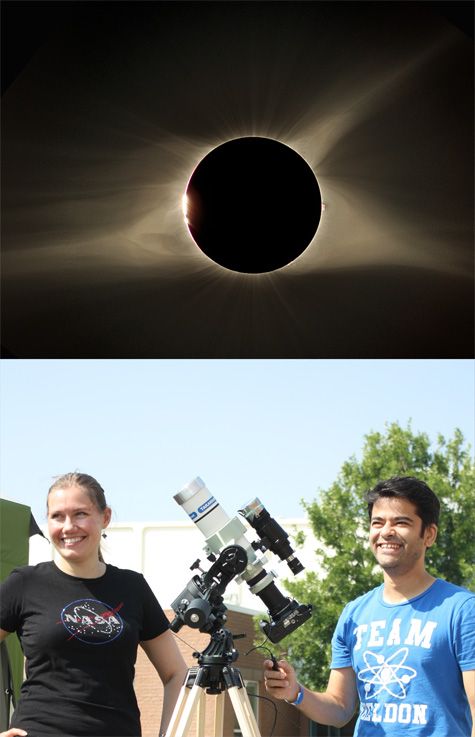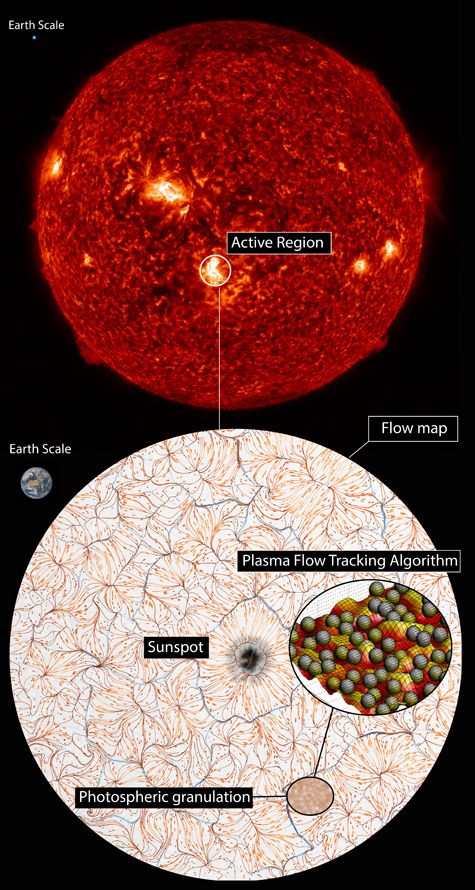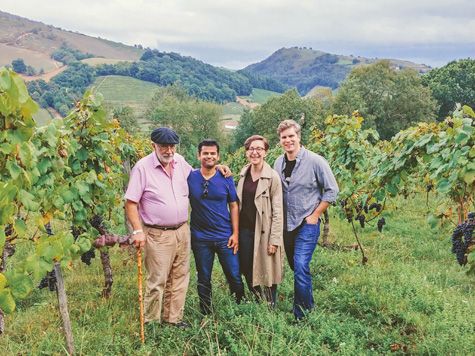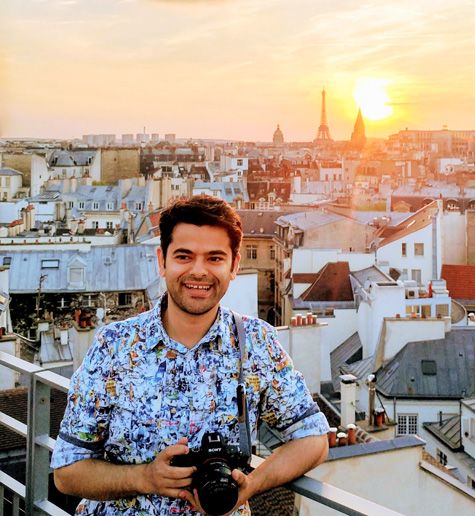Early Career Scientist Spotlight
Dr. Raphael Attié
Solar Astronomer
Solar Physics Laboratory
What inspired you to pursue a career in Solar Astronomy?
My first memory as an aspiring astronomer dates back from when I was about 6 years old. My family was outside in the garden trying to see a lunar eclipse. I searched everywhere in the sky to see it, but I did not know what I was supposed to look for. I think the fascination of my family looking at this event with all their eyes pointing in the same direction got engraved in my mind. That was my first calling. Fast-forward to the end of my Master’s degree in Astrophysics in France, I was looking for a PhD program. I interviewed for various PhD topics at the Max Planck Institute for Solar System Research in Germany: the search for water on Mars, Earth’s magnetosphere, and another area I was less familiar with, Solar Physics. The director of the institute spent some time showing me what studying the Sun was really about. I instantly became fascinated. I was dazzled by all of the dynamic and beautiful events happening on the Sun: intriguing plasma flowing like an ocean of fire and emerging from mysterious dark sunspots, flashes of energy and plasma erupting like lava expelled from volcanoes, guided by invisible magnetic field lines... Contrary to rather static deep sky objects (nebulae, galaxies, etc.), the rapid multi-scale changes of the flows and magnetic field means that the Sun never shows you the same face. Looking at it one time affects your perception of what lies beneath and somehow, each time you observe it, your perception evolves. In a metaphorical way, you could say that each time you look at the Sun, it changes because you looked at it!

Credit: Portrait photo from Lina Tran. Eclipse photo (composited) from Raphael Attié
What is your research focus?
I specialize in mapping the plasma flows at the Sun’s surface known as the photosphere, using observations of the solar surface from NASA’s Solar Dynamics Observatory (SDO). The concept behind my “flow mapping” framework originated from a new image processing paradigm developed by a colleague in Europe known as “Ball-tracking”. I implemented this paradigm in different ways to track a greater variety of solar flows at high accuracy and adapted it to different kinds of data, including SDO’s. These techniques track the little blobs of plasma in the photosphere known as “granulation”, as well as little magnetic elements that get transported in the underlying plasma flows. To achieve this, the algorithm “drops” numerical spherical tracers (hence the name “Ball-tracking”) onto the image whose intensity is converted into a geometrical axis. The “balls” are programmed to settle down in the local minima of the image intensity patterns formed by the solar granulation or by the magnetic elements. That programming is done through the numerical implementation of equations analogous to Newton’s law – an original way to convert a difficult image-processing problem into a more “physical” problem that is easier to solve. As the granules (or the magnetic elements) move, grow, and shrink, the average flow pushes the spheres in a coherent bulk motion. Because the position of the spheres is known at any time, we can infer the plasma flows that were pushing them. To assess the accuracy of this technique, realistic magnetohydrodynamics (MHD) simulation of the photosphere are used. Then our technique turns into an optimization problem where we minimize the error to fine-tune our algorithm. More recently, with a co-worker specialized in Artificial Intelligence at the National Solar Observatory, I started investigating Deep Learning Neural Networks to see how they can help to analyze plasma flows at smaller scaler than what my flow mapping framework can reveal.

Credit: SDO/AIA/HMI | www.helioviewer.org | Raphael Attié
What does a typical day at work look like for you?
Very often, I have to take the hat of a data scientist. SDO observes the sun 24/7 nearly continuously and sends about 1.5 TB of solar observations per day. I do not use all of it, but I often have to comb through it to find interesting events to study. Fortunately, I work with a great team and my co-workers know what they are looking for. They send me interesting events on the Sun to look at in more detail, with a time and location on the Sun’s surface. That is enough for me to extract the slice of data of interest. After I collect and order a pre-processing of the data from SDO’s remote data archive hosted at the University of Stanford, I tune and run my algorithms to create and analyze the Sun’s surface flow maps. The output of our solar flow tracking framework are maps of the Sun’s surface flows, which resembles wind streams or ocean streams sometimes shown on Earth’s weather forecast. This resemblance sometimes makes me think that one day we could have a nice-looking Earth-like weather forecast of the Sun!
What research accomplishment are you most proud of?
During my PhD, as I started to apply my new solar flow mapping framework, my supervisor and I revealed the existence of large-scale twisted flow streams, bigger than the size of Earth, that look like a big vortex. At the center of the twisted flow lines, the magnetic flux gets intertwined and activates little eruptive events (like very small flares). These phenomena and interactions between the magnetic field and the solar flows appeared to be ubiquitous in the solar atmosphere. It was only a few years later, once I got the chance to work at NASA, that my framework proved to be the most efficient of all photospheric flow mapping algorithms in our field. This is enabling many collaborations and research ideas for interns, PhD students and PostDocs. It is a very rewarding feeling to see that your research is inspiring other scientists.
What is one research project that you are particularly excited about, and why?
In our field of Solar Physics, I am interested in finding predictors of solar activity. In particular, I like to investigate how to best estimate how much energy is stored in magnetically active regions to infer how powerful a solar eruption can get, should any occur. In other words, the key question that drives many of us: can we see the storm brewing? For example, auroras are a beautiful manifestation of so-called “space weather” events of solar origin. What is less heard of are the hazardous events from the Sun impacting our modern infrastructure as well as interplanetary space travel that put astronauts at risk of solar radiations. In the 19th century (1859), a solar flare occurred that was so powerful that it knocked out the telegraph systems in Europe and North America. It was much later after the event that we understood what actually happened. Fast-forward to the 21st century, with our inhabited space programs and our strong dependence on communication systems and power grids, understanding how the Sun and other Sun-like stars power themselves and what makes them erupt has become not just a fundamental astrophysical question, but also a societal necessity.
Are you involved in any upcoming space missions?
Recently, I have become involved in NASA’s PUNCH mission, which will study the Sun’s outer atmosphere (the corona) to better understand the effects of space weather. The team brought me onboard for my expertise in mapping plasma flows and asked me to investigate to what extent my techniques can be applied to observations of the plasma flows in the corona. For the first time since I got into Solar Physics, my research focus gets to leave the surface of the Sun. It is very stimulating!

Credit: Arnaud Youakim
What do you like to do in your free time?
My French heart must stress that cooking comes first, and astrophotography second! Capturing those nebulae is tough to do in the D.C area. Could someone switch off the lights?? For this reason, with my brother and a couple friends, we rented a remote spot in Spain with an automated observatory. We operate our telescopes remotely from our homes. Finally, I enjoy building mini drones with my 3D printer in my “home lab”. Building drones fascinates me because it is a focal point of STEM creativity. I usually get my inspiration in sci-fi movies to make them cool-looking. Sometimes I give them a more “da Vinci” look by using plywood that I reinforce with epoxy resin and glass fiber cloth. My ongoing project is inspired by the “Bubbleship”: Tom Cruise’s craft in the movie “Oblivion”. I would love to have this hobby inspire our kid so that she gets to pilot spaceships at a very young age.

Credit: Cécile Dekoninck
Biography
Home Town:
Biarritz, France
Undergraduate Degree:
Bachelor in Fundamental Physics, Université Paul Sabatier, Toulouse, France
Post-graduate Degrees:
M.Sc in Astrophysics, Université Paul Sabatier, Toulouse, France
Ph.D Max Planck Institute for Solar System Research, Göttingen Germany

